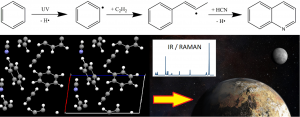Undergraduate and PhD projects are offered for each of the topics below. If you are interested please get in touch!
Solid-state Astrochemistry:
The Ennis group is interested in the formation of organic molecules that have been identified in exotic extraterrestrial locations, such as cold interstellar clouds, the icy surfaces of outer Solar System moon and comets, as well as the hazy atmospheric aerosols of Saturn moon Titan. Here, we focus on the potential role of cyanides in the solid-state formation of heterocyclic molecules such as nucleobases – some of life’s essential building blocks. Employing laboratory FTIR techniques and synchrotron THz spectroscopy, we can resolve complex chemical processes by simulating the physical and radiation conditions of these space environments. In this way we hope to identify new efficient pathways to early biological molecules.
Read latest: “Mixed Hydrocarbon and Cyanide Ice Compositions for Titan’s Atmospheric Aerosols: A Ternary-phase Co-crystal Predicted by Density Functional Theory” ACS Earth & Space Chemistry (2020). DOI: 10.1021/acsearthspacechem.0c00130
Read latest: “Crystal Structure of Propionitrile (CH2CH2CN) Determined using Synchrotron Powder X-Ray Diffraction” J. Synchrotron Radiation (2020). DOI: 10.1107/S1600577519015911
Theory and Spectroscopy of Molecular Crystals:
Molecular crystals are weakly bound chemical systems commonly associated with pharmaceutical compounds and the ices of volatile molecules. They are also important to astrochemistry, forming the icy surfaces of interstellar dust grains where complex organic molecules are born. It is therefore essential that we can accurately model these environments to understand intermolecular interactions, solid-state reaction pathways, and the spectroscopic signatures of the chemical constituents making up the molecular crystal (that may contain many co-crystallised molecular components). To model this chemistry, the Ennis group employs periodic density functional theory (DFT) to further understand the chemical and physical properties of planetary and interstellar ice surfaces.
Read latest: “Synchrotron far-infrared spectra for the characterisation of molecular crystals of forensic interest: Amphetamine, methamphetamine, MDA, MDMA and substituted methcathinones” Vibrational Spectroscopy (2020). DOI: 10.1016/j.vibspec.2020.103115
Read latest: “The Prediction of Far-Infrared Spectra for Molecular Crystals of Forensic Interest – Phenylethylamine, Ephedrine & Pseudoephedrine” Forensic Chemistry (2020). DOI: 10.1016/j.forc.2019.100204
Supramolecular Gas Adsorption
In collaboration with established Otago chemistry research groups (Hanton, Meledandri), the Ennis group has coupled vibrational spectrocopy with the periodic DFT modelling of gas molecules adsorbed within supramolecular architectures. Including metal-organic framework (MOF) and coordination polymer systems, it is hoped this approach can add to our understanding of gas adsorption thermochemistry and contribute toward the development of carbon dioxide sequestration and hydrogen storage materials.
Read latest: “Subtle Influences of a Flexible Tecton on an R22(8) Carboxyl Dimer Synthon: From Molecular Threading to 2D → 3D Interpenetration” Cryst. Growth Des. (2020). DOI: 10.1021/acs.cgd.0c01104


